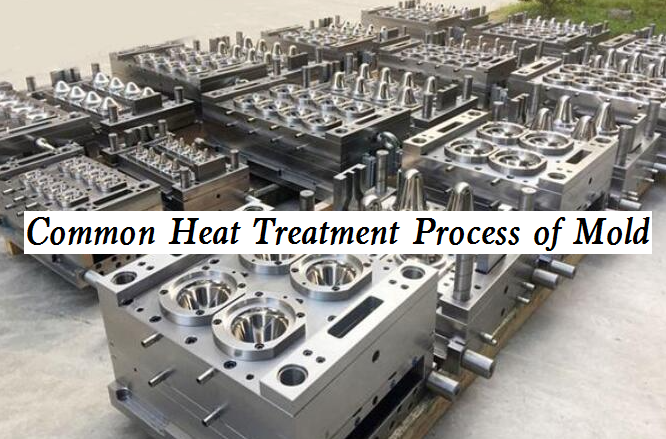The performance of materials has a substantial impact on the durability of injection or casting molds. One of the most important responsibilities of mold engineers is the selection of mold materials based on the structure and function of molds. Heat treatment and surface reinforcement are the most important processes for ensuring the quality and durability of molds. Real-world application has demonstrated that improper heat treatment is a major cause of mold failure. Let’s examine the most prevalent mold materials and heat treatment processes.

Common Types of Mold Materials
Mold steel can be divided into three categories according to its purpose. The general principle of selection is to meet the requirements of service performance, good process performance, and proper consideration of economy.
1. Cold work tool steel: mold for making metal deformation in a cold state, including cold stamping die, cold extrusion die, cold upsetting die, and powder pressing die. It requires high hardness, high wear resistance, and sufficient strength and toughness.
2. Hot work tool steel: it is used to manufacture the mold formed by heated solid or liquid metal under pressure, including hot forging die and die casting die. It requires sufficient strength, toughness, and wear resistance at high temperatures, as well as high thermal fatigue resistance and thermal conductivity
3. Plastic mold steel: manufacturing all kinds of plastic molds. There are many kinds of plastics with different requirements, and the range of mold materials is wide.
The main performance requirements of die steel:
– Hardness and wear resistance (the most important form of die failure determines to die life)
– Machinability (the shape of die parts is complex, requiring small heat treatment deformation)
– Strength and toughness (sufficient strength to withstand high pressure, impact load, and other requirements)
– Hardenability, polishing, and corrosion resistance (corrosion effect of plastics and additives).
Common Heat Treatment Process of Mold
Mold heat treatment includes mold material heat treatment and mold parts heat treatment.
– Heat treatment of die material: it shall be completed in the steel plant to ensure the quality of steel, such as basic mechanical properties and metallographic structure, which shall comply with national standards or industrial standards. It is characterized by mass production in large industrial furnaces.
– Heat treatment of mold parts: completed in the mold manufacturer or professional heat treatment plant. It is characterized by small batch or single piece production, complex and diverse processes, and sophisticated equipment.
The heat treatment process includes preparation heat treatment and final heat treatment. Common methods include normalizing, annealing, quenching, quenching and tempering, carburizing, and nitriding. What heat treatment process is used for different types of mold materials?
Cold Work Tool Steel Heat Treatment
Cold working mold is mainly used for blanking, stretching, bending, and other processes of metal or non-metallic materials. The working parts bear various mechanical forces such as tension and compression, bending, impact, fatigue, friction, and so on. The main failure forms include fracture, collapse, wear, adhesion (bite), gnawing, softening, etc.
– Heat treatment of carbon tool steel: it is used for small simple cold working die working parts with low requirements (T8A, T10A). T10A is the most widely used, with high strength and toughness. The hardenability of carbon tool steel is poor, and the hardened layer is 1.5 ~ 3.0mm after conventional quenching.
– Heat treatment of low alloy steel: commonly known as oil quenched steel, this kind of steel generally has low quenching temperature, cooling in oil, small deformation, and good dimensional stability.
– Heat treatment of high alloy steel: it is mainly high chromium high carbon steel with high hardenability and micro deformation, also known as micro deformation steel. It is a high-grade cold working steel.
Plastic Mold Steel Heat Treatment
– Pre-hardening steel generally refers to the steel that has been subject to final heat treatment (quenching and tempering) in the steel plant. Typical pre-hardened plastic die steel: sm3cr2mo The heat treatment process is 840-880 ℃ quenching, oil cooling, 600-650 ℃ tempering, air cooling, and supply hardness of 32hrc.
– Typical heat treatment of free cutting pre-hardened steel: annealing at 800 ± 10 ℃, holding for 2-4h, cooling to 700-720 ℃, holding for 4-6h, furnace cooling, hardness < = 229hbs, quenching at 880-920 ℃, air cooling, hardness 63hrc, tempering at 160-200 ℃, air cooling, hardness > = 58hrc.
– Nonalloy medium carbon plastic die steel is a medium carbon structural steel with higher metallurgical quality (purity), with a C content of 0.4% – 0.6%. Typical materials are SM45 and SM50. Its heat treatment process is no different from the conventional process. For small plastic mold parts with low precision requirements, this steel is the first choice.
– Corrosion-resistant plastic mold steel is used to manufacture plastic products and mold parts that corrode metals. Typical steel types are Cr13, 9Cr18, and other martensitic stainless steels that can be strengthened. Its heat treatment is the same as that of general stainless steel products.
Hot Work Tool Steel Heat Treatment
Hot working dies mainly include forging die, hot extrusion die, die casting die, etc. the main failure forms are fracture (crack or mechanical fatigue crack), plastic deformation or cavity collapse, thermal fatigue, thermal wear, and hot melt loss.
– Hot working die steel with high thermal strength is mainly used to make working parts of die-casting die and machine forging die. High thermal strength, thermal fatigue, hot melt loss, tampering resistance, and thermal stability are required. Generally, it contains more Cr, W, Si, Mo, V, and other alloy elements. Representative steel grades are: 4Cr5MoSiV, 4Cr5MoSiV1, etc.
– High wear resistance hot working die steel has good hardness, good thermal wear resistance, high-temperature strength, high-temperature toughness, and thermal stability. Representative steel grade: 3Cr2W8V. High quenching temperature: 1100-1150 ℃. In order to reduce deformation, the temperature rises slowly and preheats complex and large parts.

